For jobs around the homestead, having the proper hand tools is essential. Equipping yourself with the best tools for the job makes everything much quicker and easier, getting things done correctly the first time around. Chainsaws, cultivators, and weed whackers have their place but aren’t always reliable. Hand tools get the job done without the need for gas, oil, or electricity. Here are 35 of the best farm hand tools and their uses.
What You'll Learn Today
- 1. Adjustable Wrench
- 2. Auger
- 3. Axe
- 4. Brooms and Brushes
- 5. Buckets
- 6. Crowbars
- 7. Duct Tape
- 8. Forks
- 9. Garden Hand Tools
- 10. Hammers and Posters
- 11. Hand Drill
- 12. Hoe
- 13. Loppers
- 14. Machete
- 15. Multipurpose Tools and knives
- 16. Nail Pullers
- 17. Pickaxe
- 18. Pliers
- 19. Pruners/secateurs
- 20. Rakes
- 21. Saws
- 22. Screwdrivers
- 23. Scythe
- 24. Shovels and Spades
- 25. Sickle
- 26. Socket Set
- 27. Spanners
- 28. Spirit Level
- 29. Tape Measures
- 30. Watering Can
- 31. Wheel Jack
- 32. Wheelbarrow
- 33. Wheel Wrench
- 34. Wire/Bolt Cutters
- 35. Wrecking Bar
- Conclusion
1. Adjustable Wrench
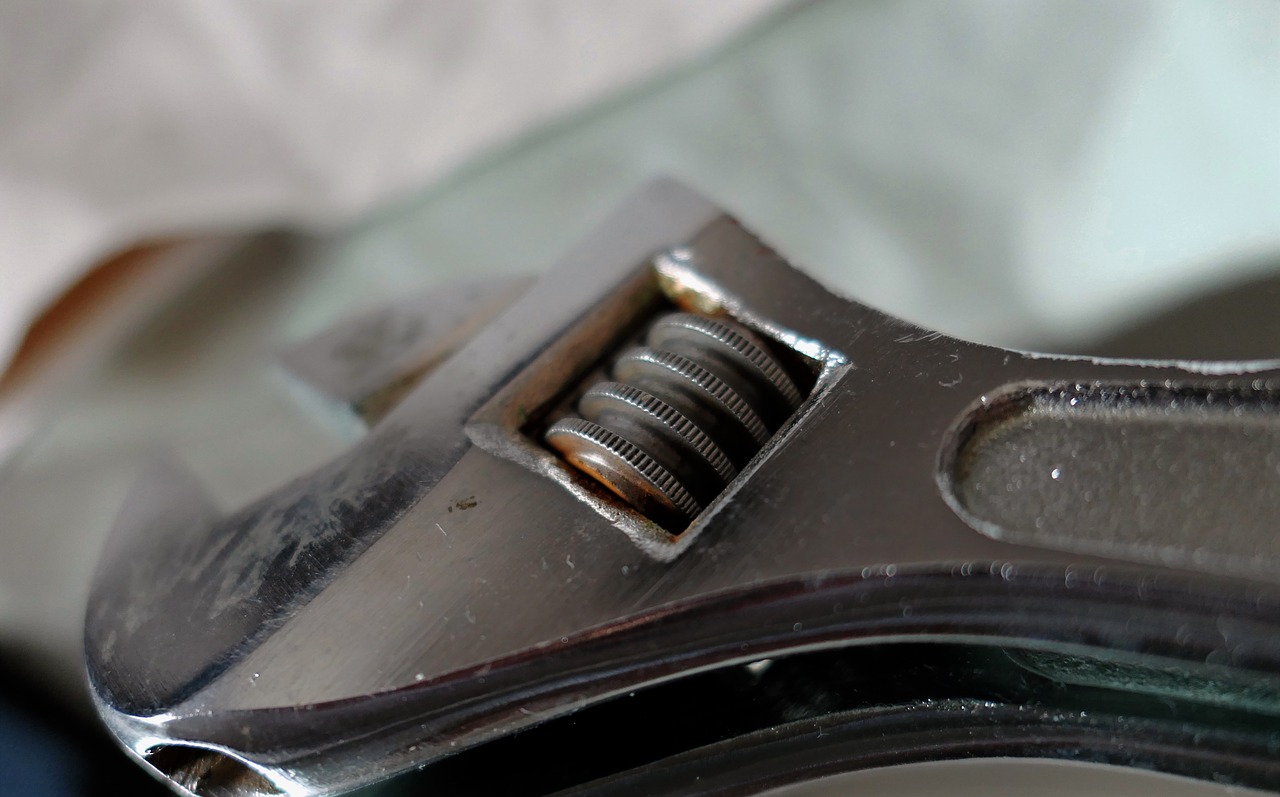
The beauty of an adjustable wrench is that you can change the size to fit around just about any bolt or other object you need to get a firm grip on.
There are a few different types of adjustable wrenches. Some have a handle that slides up and down in a grove to change the distance between the two gripping surfaces, while others have a bolt mechanism that you alter using your fingers to increase or decrease the space between the two sides.
2. Auger
An auger is a giant screw-like tool that resembles an oversize carpenters’ bit. It is a short cylindrical container that has cutting teeth around the end.
The cylinder is attached to a long rod that has a “T” handle on the top. To operate it, the handle has to be turned by hand to make the teeth on the cylinder cut down into the ground and bore a hole.
You can use augers of this type to obtain soil samples or to start post holes when fencing.
Auger drill bits are similar in that they bore a long, deep hole through wood.
3. Axe
There are many different types of axes with a range of uses. On my homestead, I have just three, which serve the purpose for all the wood jobs I need doing. The first is a felling axe which has a long wooden handle and large head. Its primary use is, as the name suggests, to cut down trees.
The next axe in my arsenal is also known as a hatchet. This has a much shorter shaft and a smaller head. It is used to chop off branches.
My final axe is a wood splitter. Like the hatchet, it has a short handle and small head. The head width is much broader than either the hatchet or the felling axe, as it is designed to split logs for the fire. The wider head prevents it from becoming stuck and also breaks the logs more effectively.
4. Brooms and Brushes
If you want your homestead to stay looking clean and tidy, you’re going to need a broom, or two, or three.
I have several different brooms for the various jobs around the place. The one I use most often is a yard broom. This has a long head of about 3 feet in length and 3 inches wide. It has strong, mid-length, flexible nylon bristles. I use it to keep all my outside areas clean of debris and for clearing out animal stalls.
The next boom I use is just a regular yard broom with a much shorter head of about 1 ½ feet. Sometimes the long yard broom isn’t suitable to get into more challenging to reach places. The bristles on this broom are still nylon but are longer than those on my yard broom, the head is also a little wider.
My final broom has a much smaller head of around 12 inches and has short, very stiff nylon bristles. I use this to scrub the ground clean of dirt and muck in the animal stalls or if I’m hosing them down and disinfecting them.
A good metal dustpan and brush set are also a beneficial acquisition. I use them all the time to clear up sawdust when I’m making things. Or just to keep my work areas clean.
5. Buckets
Buckets around the homestead are invaluable for watering animals, washing items, and carrying things.
I have various types of buckets for different jobs. Large tubs with molded handles for soaking feed, smaller strong plastic work buckets with metal handles for making concrete, carrying sand, or collecting old nails, not to mention various water and feed buckets.
6. Crowbars
Crowbars are long metal shafts with a forked hook on one end and an angled blade on the other. There are different types and sizes of crowbars for all kinds of building jobs.
We have a selection of four in total. These are of varying lengths and thicknesses. Some have very special heads explicitly designed for dismantling wooden pallets, which we do a lot.
Even having one crowbar will be handy for removing nails out of wood or for levering things apart.
7. Duct Tape
OK, so I admit duct tape isn’t per se a tool, but we use it so much around the place that I just had to include it in the list.
Duct tape is a strong sticking tape with fabric running through it. It’s your go-to repair all, great for fixing all kinds of stuff from holey tarps to cracked gutters.
There are various types of duct tape for different uses. We always carry the waterproof kind to fix split hoses or other things that get wet.
I’ve also found it great to use in animal emergencies as a makeshift dressing holder. Using duct tape you can patch up a wound or poultice a hoof. Keep in mind, however, that it isn’t actually sterile.
8. Forks
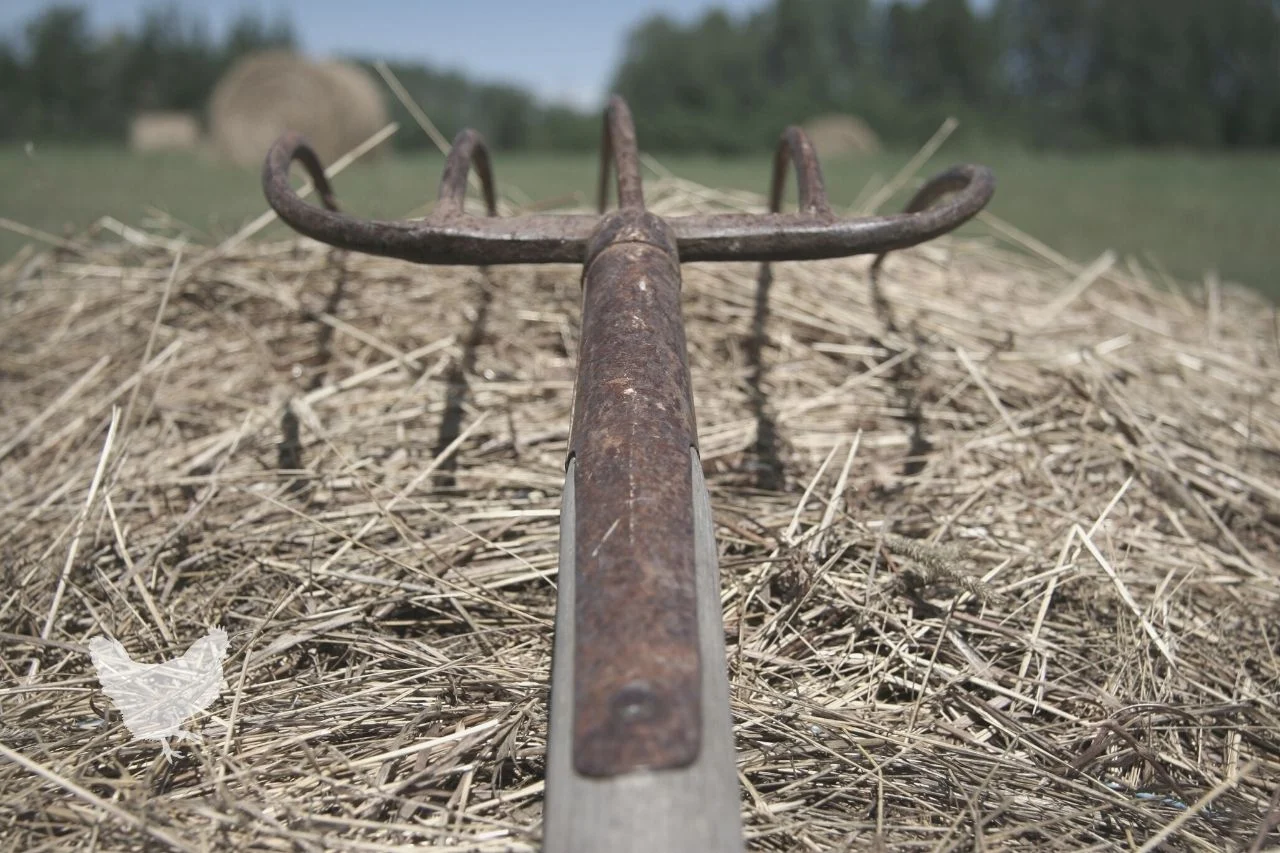
The three essential forks to have are a garden fork, a pitchfork, and a hand fork.
Garden forks have handles roughly the length of your leg with a handle on the end. The fork itself has a flat top so you can stand on it with your boot to push it into the ground. There are usually 4 or 5 flat, square or rounded tines.
You can use garden forks for turning over soil, digging up root vegetables or weeds.
A pitchfork finds its place in the barn or stable and has a long shaft that will reach around shoulder height. The fork itself has an arched top and 2, 3, or 4 rounded tines with sharp pointed ends.
Pitchforks are great for cleaning stalls, moving small bales, feeding hay, or fluffing bedding.
Hand forks are small hand tools. The shaft and the head are both about the length of your hand. The fork itself usually has 3 or 4 broad, flat tines.
You can use these small hand forks around the vegetable plot or flower bed to remove weeds, make holes for planting or dig up root veg.
9. Garden Hand Tools
Garden hand tools include hand forks, trowels, hand rakes, and hand hoes. They are basically miniature versions of their full-size counterparts and are used around the homestead garden for weeding, planting, and harvesting.
I often use a strong hand trowel when I’m digging holes for gate posts, as I want the hole to be deep but narrow and a hand trowel is easy to get down to the bottom for scooping out the dirt.
In this video, you can see a commercial market gardener’s favorite tools and how he uses them to make his job more manageable.
10. Hammers and Posters
A hammer is an absolute must around the farmstead. Other than just banging in nails, hammers can be used for other jobs too.
We have many hammers – claw hammers, sledgehammers, tack hammers, lump hammers, and mallets.
Claw hammers are excellent for fencing jobs such as tensioning wire and putting in fencing staples. You can also use them to remove old nails from wood.
Sledgehammers are long-shafted hammers with large, heavy square heads. They are used chiefly for putting in posts, although, in truth, I’m not strong enough to use them for that job and prefer the help of a cylindrical metal poster that slides over the top of a fence post.
You then hold the two long handles that run down each side and lift it up and drop it down repeatedly to drive the post into the ground.
You may think a metal poster would be safer than using a sledgehammer, but my husband has had them land on his head, almost knocking him out on several occasions.
You can also use sledgehammers to break up surfaces or take pallets apart with a crowbar.
Tack hammers are little hammers with a small round hammering side at one end of the head and a tapered flat point at the other. They’re for hammering in tacks when upholstering furniture or holding in wooden shelves.
Lump hammers are rather like baby sledgehammers but with a much shorter shaft. If something needs a bit of persuasion in the form of a good hard whack, then a lump hammer is your tool!
Mallets have shafts around the length of your lower arm and come with a variety of different heads. Rubber or wood are standard and are helpful when you want to ease something without damaging it. We use them for laying floor tiles or making furniture.
11. Hand Drill
Life for me would be impossible without a drill! The truth is I use my battery and electric drills all the time, but they aren’t always helpful when the power’s out, or you’re stuck in a field.
When making a large bale feeder last winter, the wood I’d chosen to use was so hard that my battery drill kept stopping and just wasn’t strong enough for the job. Eventually, I had to resort to using a hand drill fitted with an auger bit to drill the holes for the bolts to go through.
Just like with other types of drills, hand drills allow you to fit various types of bits. They usually have a handle that works on a cog system, driving the power you put in by turning the handle and multiplying it to turn the drill bit into the wood.
Sharp bits are the key when using hand drills!
12. Hoe
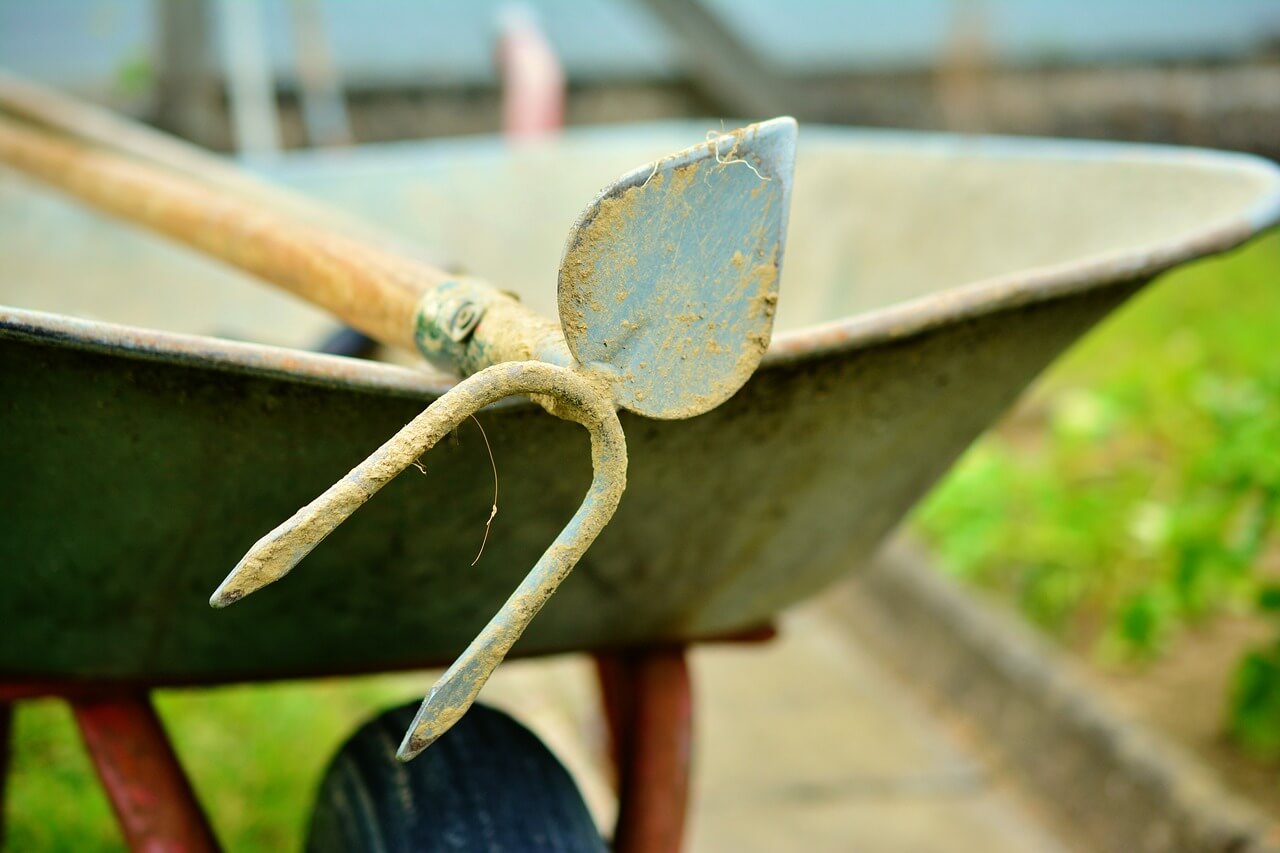
A garden hoe can save you hours of back-breaking weeding on your hands and knees. A hoe has a long shaft, usually around shoulder height.
The end has two arms that support an angled metal blade generally of about 6 to 8 inches in length.
While standing upright you use the hoe to remove young weeds from your vegetable plot or flower beds. Or you can use it to cut off the tops of weeds on a pathway.
13. Loppers
If you need to cut off tree branches or attack a dense thicket, then a good pair of loppers is essential.
They fall into two categories, true loppers, and sheers. Loppers have a pair of long-shafted handles approximately the length of your entire arm. They then have a strong, curved top blade and a flat or curved receiving blade, dependent on type.
The principal use for loppers is to cut off tree branches up to 1 to 1 ½ inches in thickness.
Sheers have shorter handles about the length of your lower arm, the blades on these are long like a pair of giant scissors, but you use them in a clapping motion rather than an up and down one. Sheers are helpful for removing briar patches or clipping hedges.
14. Machete
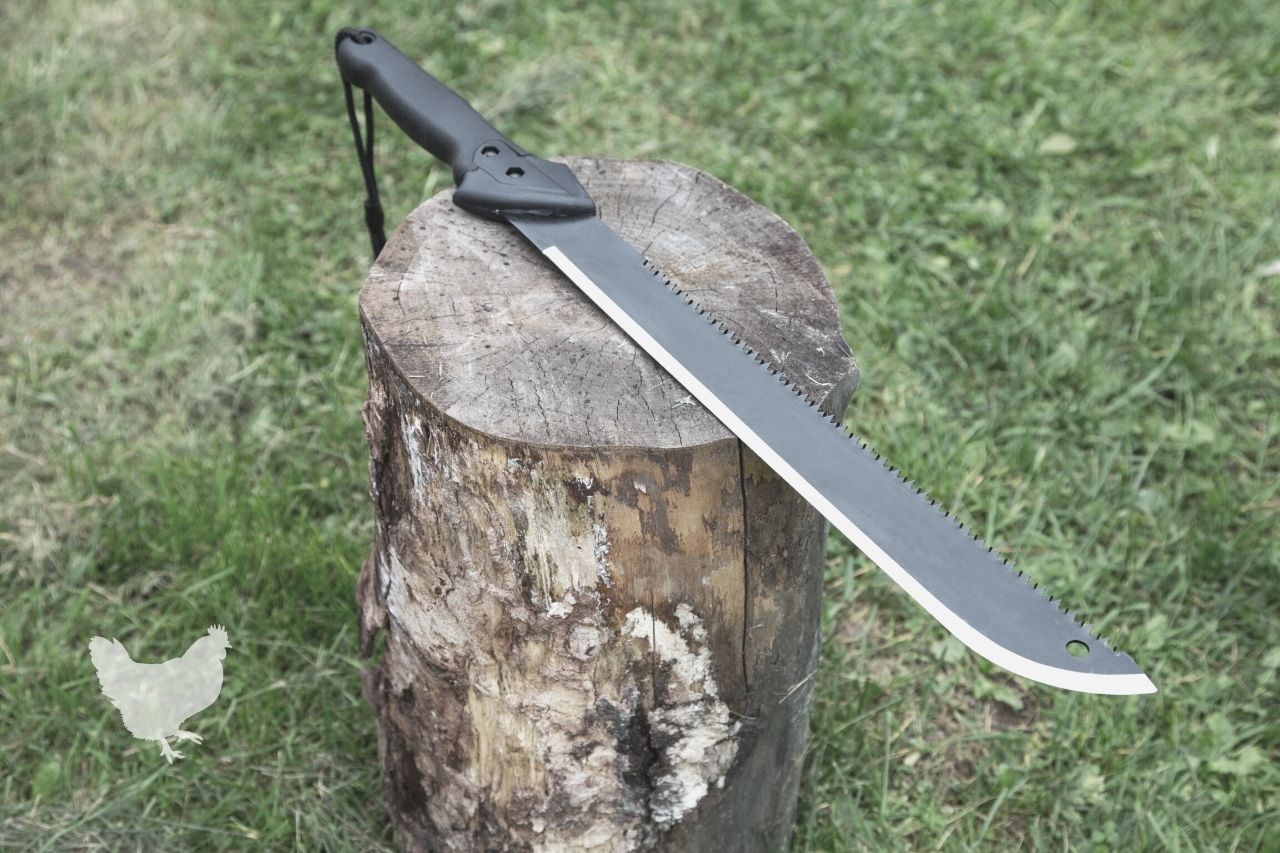
Probably one of my husband’s favorite tools, you can use a machete to clear away thin branches when you’re making a pathway, splitting wood for kindling, or carrying around so you look like some kind of crazed warrior. I figure you can guess who I’m talking about here…
We have a Fiskars Machete And A Brush Axe which have outlasted any that we had before. We got them in 2012 and they’re still going strong.
You’ll need to sharpen your machete regularly using a sharpening stone, as it will quickly become blunt. When not in use, wrap it in an oily rag or protective sleeve to maintain the edge.
15. Multipurpose Tools and knives
Small multi tools can be a real lifesaver. We carry one in our car that incorporates a small hammer, knife, screwdriver, corkscrew, mini saw, and pliers! I can’t tell you the number of times we have had to use it to “save the day!”
There are a vast array of these types of tools, from Swiss army knives down to specialist electricians sets. I recommend investing in a couple you think would best suit your needs.
16. Nail Pullers
We take apart many wooden pallets and use the wood for a multitude of purposes, from making garden furniture and fencing to rustic supports and frames for my artwork.
You may mistakenly believe that taking a pallet apart would be easy. Well, believe me, some of those suckers ain’t having any of it! This is when having the right tools for the job come into their own.
Nail pullers are a vital component if you want to remove nails easily from wood, along with a claw hammer, crowbar, sledgehammer, and lump hammer.
17. Pickaxe
The number of times you’re going to need a pickaxe may not be many, but believe me, they can make digging a trench a heck of a lot quicker than trying to do it with a shovel alone.
A pickaxe can have various shaped heads, but the most common kind has a long, dull pointed spike at one end and a flat, blunt blade at the other. They are mounted on a long shaft about the length of your leg.
As with a sledgehammer, I’m not strong enough to use a pickaxe in the way it’s meant to be used, long over the head swinging motions. Also, I value my feet and legs too much to even try it!
I still use them less dangerously to dig trenches or start holes without swinging them over my head.
18. Pliers
Ahh, pliers, another wonderful multi-functional tool, and one prone to disappearance no matter how many you buy.
Pliers come in various styles with different shaped heads for an array of jobs. They work using a scissor action and have a pair of handles usually covered in rubber for a comfortable grip.
Use them to hold things tightly such as bolts, or bend metal, cut wire, and more besides.
19. Pruners/secateurs
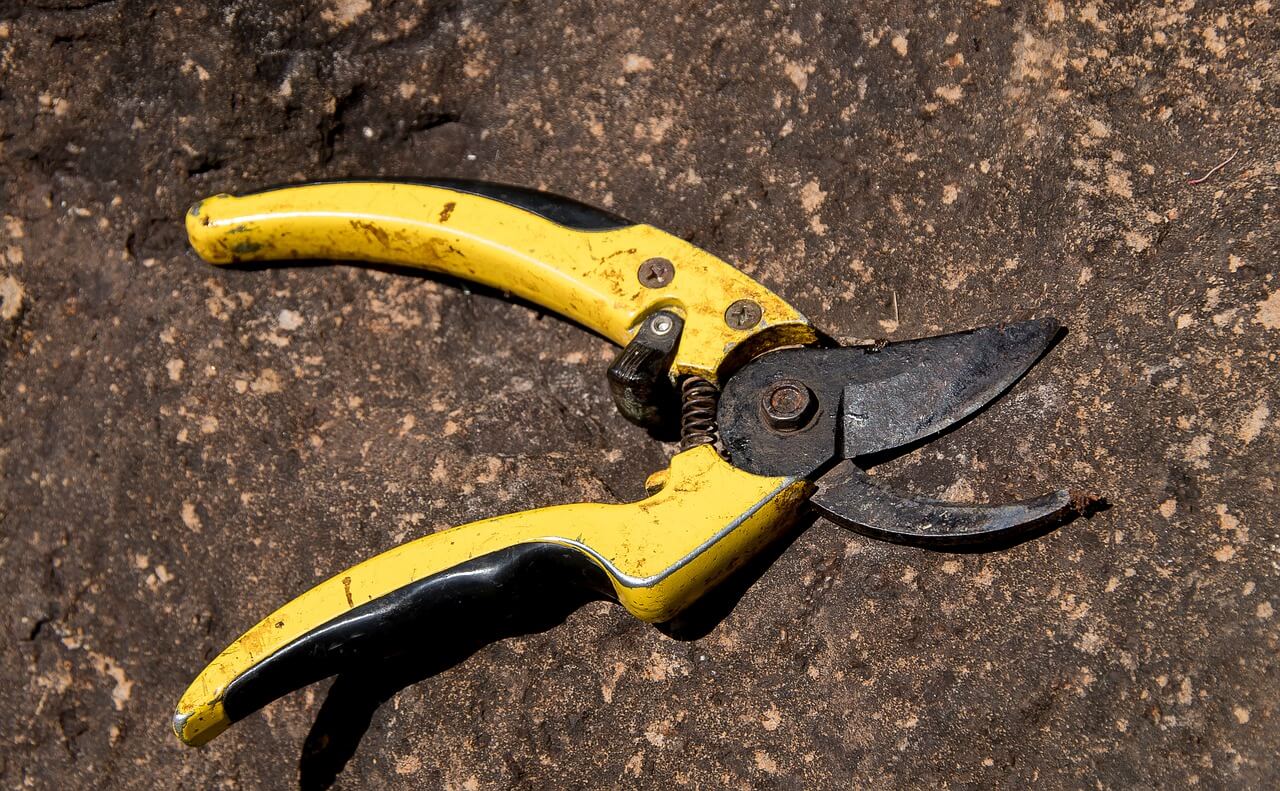
Pruners, also called secateurs, are mostly used for gardening jobs such as trimming the branches of rose bushes.
They have a sharp curved top blade and a slightly thicker bottom blade. They can be locked shut to avoid injury and maintain sharpness.
Some secateurs are also sprung to make it easier for people with poor hand strength to still cut effectively.
20. Rakes
Different types of rakes have different jobs. We use a leaf rake to clear fallen leaves and grass cuttings and a garden rake (dirt rake) to make the soil in the vegetable garden into a fine, even tilth for planting in the spring. You can also use them to rake over gravel and remove any debris that’s accumulated.
A leaf rake has flexible tines that act like springs. This helps the rake head move easily over uneven ground such as lawns. They have a long handle about shoulder height, and the tines are set in a fan shape.
A garden rake has a long handle like a leaf rake, but the head is rectangular with fixed metal tines.
21. Saws
Saws are handy to have, but you do need the right one for the job, and there are many different types.
We have a selection of hand saws. My favorite brand are Stanley Jet Cut saws which have a special tooth arrangement that makes cutting through even the hardest of wood a breeze, plus I find they stay sharp for longer than others, making them an excellent investment.
I use a Stanley Fat Max Fine Finish for cutting all kinds of things, and it’s often faster than using an electric jigsaw or even a circular saw.
Another helpful saw for making your own furniture is a miter saw. When used in conjunction with a miter block, this allows you to cut precise angles in your wood.
If chainsaws leave you feeling nervous like me, then a good quality, sharp, cross-cut saw is what you need to tackle cutting up big logs. They need two people to work them, one on each side, but can make short work of even large logs.
22. Screwdrivers
Getting a set of screwdrivers is a worthwhile investment. Screwdrivers come in a range of different sizes with various different head types, from flatheads, to crossheads, to star drives and hex drives.
If you don’t want to buy every type of screwdriver under the sun, then a worthwhile alternative is to get a comprehensive set of heads that fit into a ratchet screwdriver.
Ratchet screwdrivers take the hardship out of tightening and loosening screws, as you just need to make small back and forth wrist movements rather than having to turn the screwdriver right around for every revolution of the screw.
23. Scythe
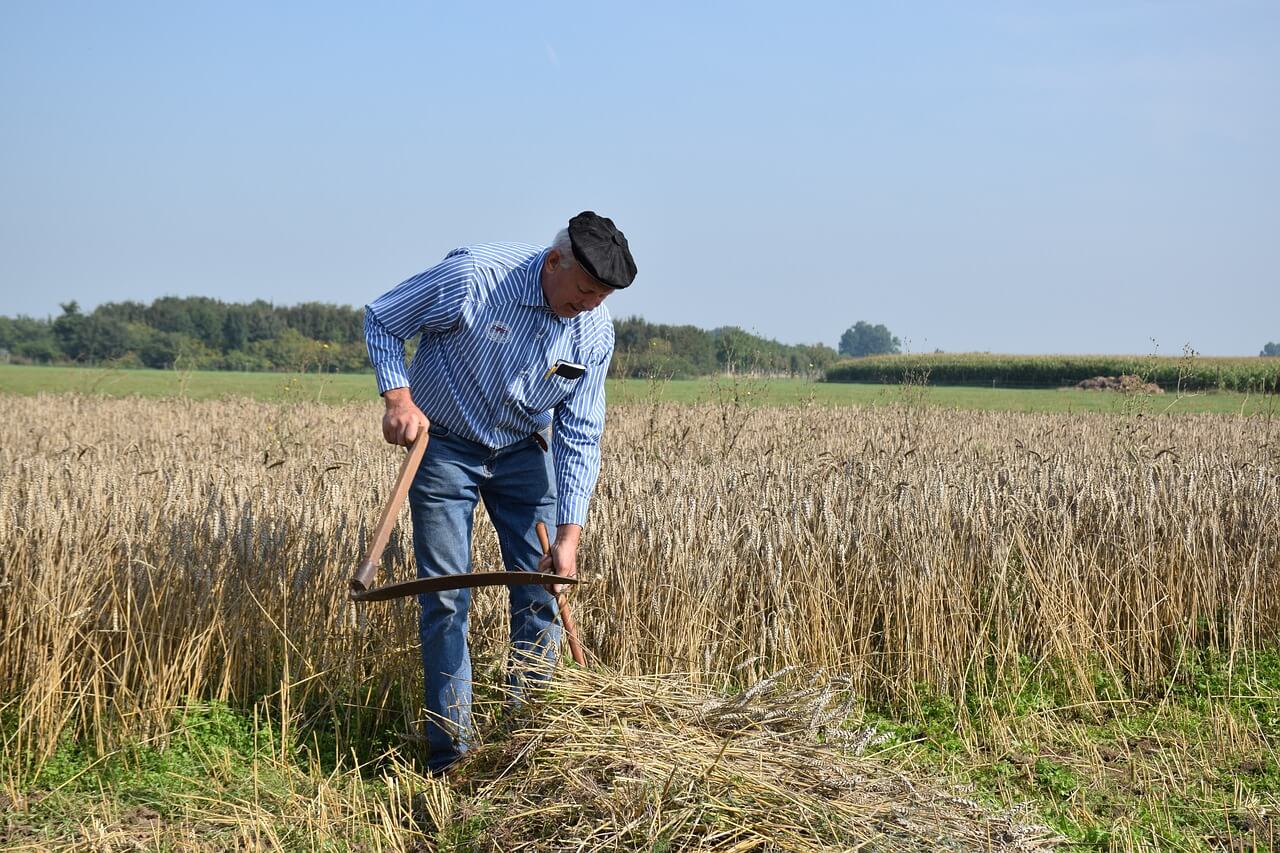
Think about the tool carried by the Grim Reaper, and you’ll know what a scythe is. They also feature in many paintings by grandmasters from bygone eras.
Scythes have been used for centuries to cut down crops during the harvest. They are comprised of a long, sharp, slightly curved blade set at a right angle to a long wooden bow-shaped handle with an additional wooden strut projecting from it for you to hold.
Today, scythes are used more for cutting back weeds and maintaining wild grassland areas, but they can be a helpful addition if your Weed Whacker is not in service.
24. Shovels and Spades
Although often confused, shovels and spades are not, in fact, the same thing. A shovel has a long handle to about shoulder height, and the shovel itself can be pointed or flat at the tip.
A spade has a short shaft with a handle on the end and comes to around hip height. Spades can have different size ends and may be narrow or broad, but they always feature a flat top for putting your foot onto and pushing the spade into the ground, something shovels don’t have.
Both shovels and spades can be used for digging holes, although a spade is more effective in heavy ground.
Shovels are used more often for moving sand, gravel, or dirt around.
25. Sickle

Like scythes, sickles have been around for 1000’s of years. You can again see them depicted in many paintings of olden day harvest time in Europe.
A sickle has a long, very curved blade set into a short wooden handle. A sickle, like a scythe, was used to cut down crops for harvest.
Sickles can be valuable tools for managing briar patches or cutting back weeds around gates and fence posts.
26. Socket Set
A socket set is usually used by car mechanics to loosen, remove, or tighten the nuts and bolts found in car engines. Bolts can be found in many other places too, on buildings, machinery, and even modern furniture!
A socket set is a way of dealing with bolts quickly and easily with a minimum of stress. Simply find the right-sized end to fit over the nut in question, place it onto the best handle for the job in your socket set, and away you go.
Socket sets come with a wide variety of sizes, ranging from tiny to very large. Some sets won’t cover all sizes, so you may need several different ones if you want a socket for everything.
27. Spanners
Spanners, like socket sets, are used on the nuts on bolts. They are tricker to use than a socket set as they can slip off of the nut easily. However, having a broad range of spanner sizes is often very useful, especially when the gap around a bolt is too small to fit the head of a socket.
28. Spirit Level
Nothing is worse than having a wonky set of shelves, a crooked fence, or an uneven floor. Having the right spirit level to check that things are either flat or upright can be indispensable if you value your sanity.
Spirit levels range from around one foot to six feet in length and are generally made from lightweight metal or plastic. They have a small glass vile set into them, containing a liquid in which there is a bubble.
On the glass vile, you will see two black lines. The idea is, when the spirit level is, well, level, the bubble will sit precisely between the two black lines. If things aren’t quite where they’re meant to be, simply adjust until they are.
29. Tape Measures
Another invaluable tool that has a nasty way of vanishing just when you need it is the tape measure. I can’t say how many tape measures I’ve purchased over the years, but it’s a lot!
It’s best to get a range of tape measures for different jobs – we have them of all different sizes that can measure vast distances out in the fields or just small lengths for when I’m making furniture.
The tape part of the measure can be metal, plastic, and even cotton. Some are automatically retractable when you press a button, while others require you to turn a small handle to reel them in.
30. Watering Can
A good quality metal watering can last you a lifetime. Hosepipe bans can mean no more watering of your vegetable patch unless you have a watering can.
Also, if you’ve just planted a new tree or bush, you’ll need to water it in, and for this, a watering can is ideal.
31. Wheel Jack
You never know when a wheel will need changing, but wheel jacks can have other uses too. If you need to hoist something up while you work on it, I had to do this to a chicken coop recently, or if you need to separate things that are too heavy to move by hand, a wheel jack can be just the tool to help you out.
32. Wheelbarrow
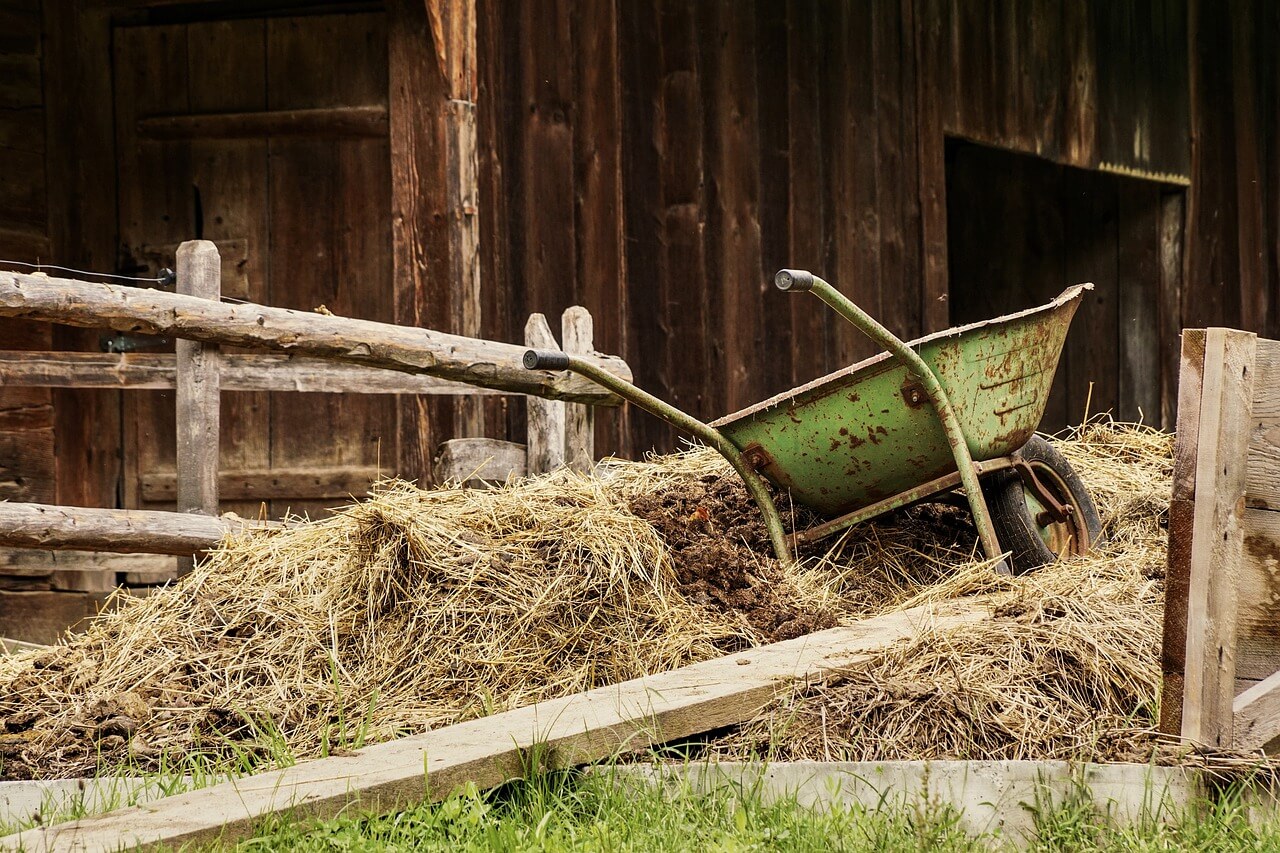
My favorite wheelbarrow doesn’t only have a giant 53-gallon bucket and two puncture-proof tires; it’s also bright pink! It makes me happy every time I use it.
I was fed up with always finding my standard wheelbarrow tire flat. What also got my goat was that the bottom of the bucket would begin to rust out within a couple of years, leaving a hole.
Although I’m not a great advocate of using plastic, it was the best choice in this instant. The double wheels make the wheelbarrow super stable, and its hollow aluminum box-frame frame keeps it lightweight.
Wheelbarrows are available in a wide range of shapes and sizes. Look for ones with puncture-proof tires and strong, lightweight frames.
We use ours to carry water or hay to the animals, do gardening jobs, mix concrete (make sure you wash out your wheelbarrow afterward), and play crazy garden games with the kids.
33. Wheel Wrench
If you have a wheel jack, that’s all very well and good, but without a wheel wrench to go with it, you’ll not be changing that tire any time soon! A wheel wrench is the most convenient way to remove the bolts from your wheel.
We don’t only have motor vehicles with tires, but a range of trailers too. It’s best to always keep the wheel jack and wrench in your vehicle in case of emergency. Plus, that way, you always know exactly where they are!
34. Wire/Bolt Cutters
If you have animals and maintain wire fencing, then a couple of pairs of wire cutters are an absolute necessity.
These bad boys have the ability to cut through not just wire but quite heavy-duty bolts if they are large enough. Bolt cutters are another tool in my arsenal for taking pallets apart.
They work using a lever-action, so by opening up the handles to their widest point, the cutting jaws only open up slightly. As you close the handles, so the lever action squeezes the strong metal jaws together cutting through the bolt.
35. Wrecking Bar
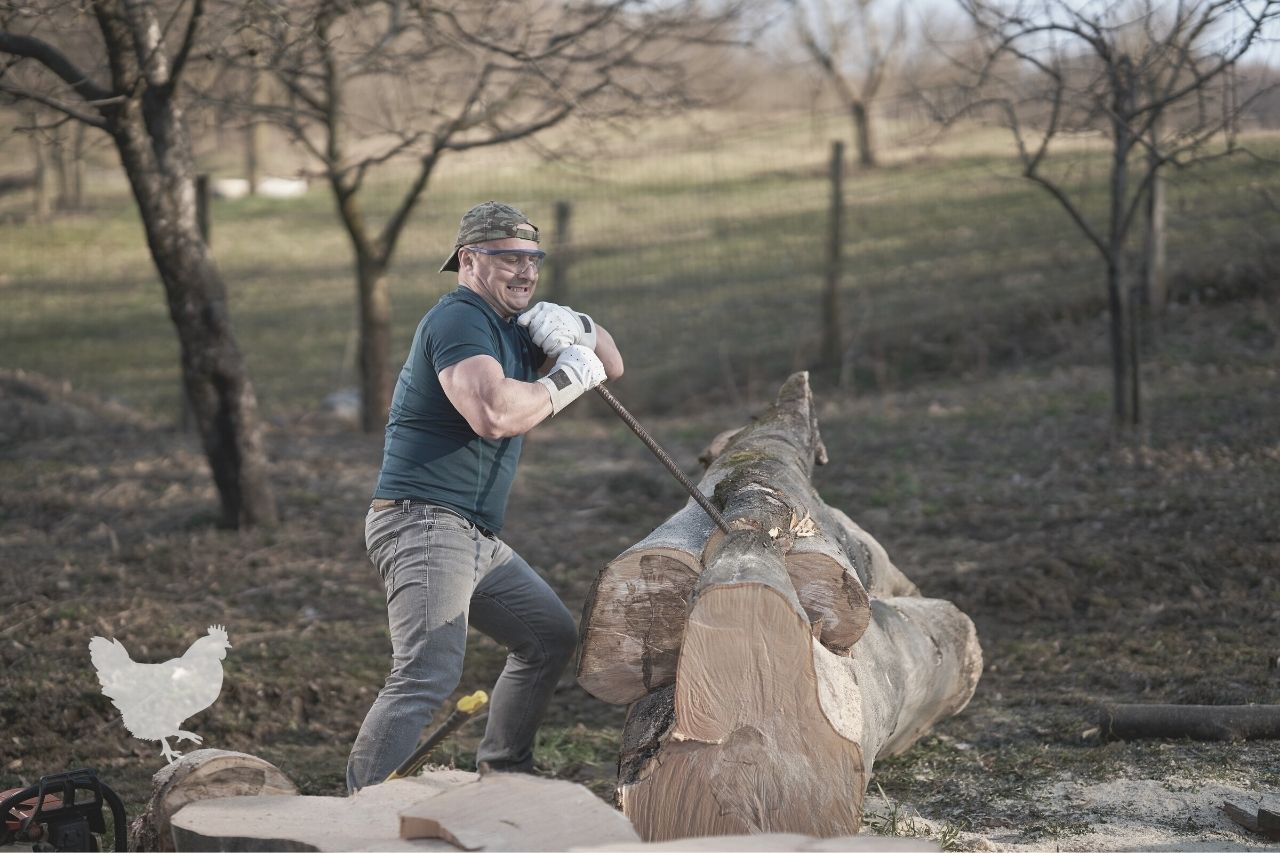
Another of my husband’s favorite tools is a wrecking bar. Great for levering heavy objects such as logs or for making deep, narrow holes.
Wrecking bars are just long metal bars that come to around shoulder height and are between an inch and an inch and a half thick. They have a slightly angled blunt blade on one end and a dull point on the other.
When I’m fencing, they are invaluable to start the hole for the fence post to go into, and you can make the hole quite deep by simply lifting the wrecking bar up as high as you can, then forcing the pointed end into the ground as hard and fast as possible.
Unlike us, don’t leave your wrecking bar lying in the grass, as you’ll probably never see it again.
Conclusion
The beauty of hand tools is their reliability. There’s no need to worry about expensive maintenance or buying gasoline, oil, or electricity to run them.
Unlike most power tools that have a relatively short lifespan, good-quality hand tools can last an entire lifetime.
Try to buy the best quality you can and go for natural materials over plastic whenever it is feasible to do so.
If you’ve found our list of farm hand tools and their uses interesting, then you’ll enjoy reading more about specific tools in our handtool series.